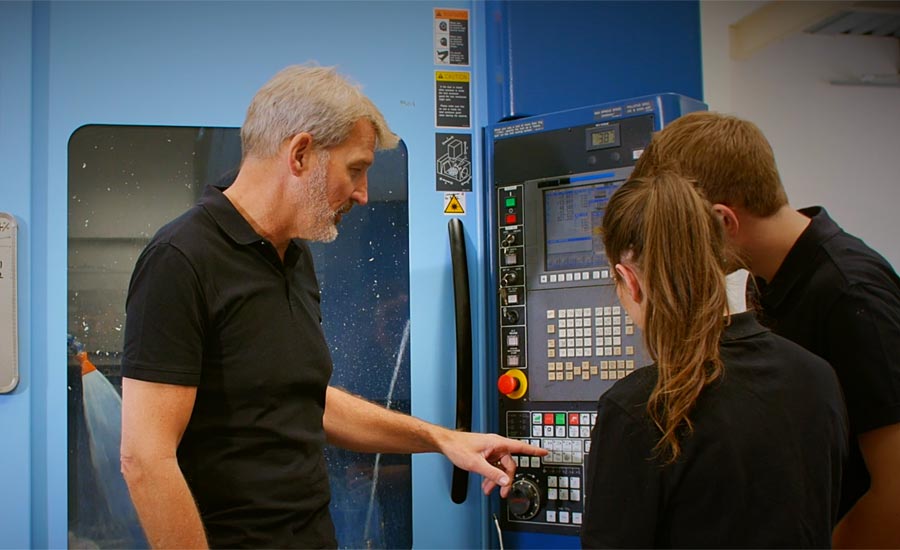When senior leaders are running machines because they don’t have enough people to staff a production line, it’s another sign of a manufacturing workforce that could use more people and more training.
When the pandemic hit, manufacturers were already behind in terms of embracing new forms of learning. This was another disadvantage for an industry that had not adopted concepts like virtual reality, says Jeannine Kunz, vice president of Tooling U-SME.
“Manufacturers as an industry are not always up to par with the best practices of industry as a whole in terms of training,” Kunz says.
But when the pandemic forced all of us to do things differently, manufacturers began trying new things as well. They embraced concepts like blending learning, GoPro learning with colleagues in remote locations, and branched out, Kunz says. If manufacturers are not up to date on best practices in training this is especially problematic.
“Quality is a huge risk when people don’t know what they’re doing.” Kunz says.

Manufacturing Institute Executive Director Explains Training Trends And Challenges
Manufacturing Institute Executive Director Carolyn Lee discusses the training challenges facing manufacturers in 2021.
To listen to more podcasts, click here.
Workforce skill improvement was largest job-related concern according to Quality’s 2020 State of the Profession Survey released last June. The survey also found that only 1% of respondents did not participate in any training the previous year. Data analytics, programming, and/or automation were the top areas of interest for training.
No matter what route you take, try something. As Kunz says, “Doing nothing is not a good plan.”
No one is saying this is easy. With manufacturers having so much to do right now, whether it’s coping with a pandemic, looking into new technologies related to Industry 4.0 or additive manufacturing, or simply fulfilling orders, it can be daunting to work on training and recruitment. But the time to start is now.
Train Your People
It’s difficult to have a well thought out training plan. But, Kunz urges, it’s important to take action, however small. This first step may deal with one department, or one plant. If it goes well, you have something to celebrate and momentum for the next task. “Even if you fail, take a step and learn from it,” Kunz says.
For manufacturers who want to step up their training and recruitment, Kunz sympathizes. It’s easy to preach what to do, but there are real obstacles in meeting these seemingly lofty goals.
“When you don’t have people, you have quality issues and difficulty meeting customer demands,” Kunz says.
In addition to using best practices in learning, engaging with schools, and having a strong onboarding process, Kunz says SME would tell manufacturers to consider what they are looking to build. Consider what’s inhibiting your goals. “However they do it, they need a vision of what’s needed,” Kunz says. “The number one thing we tell people is do something. Take a step.”
Finding New People
Schools can be a great partner for manufacturers. In fact, Kunz suggests thinking of schools as a talent pipeline that deserves just as much attention as your supply chain.
“What we say at SME is: your school is your supplier of your number one asset,” Kunz says.
Consider alternative methods of training. The costs of untrained or ill-trained staff members can be high. This can be something like a safety issue or a quality problem or simply breaking a tool.
With the rise of technology in training, there are some distinct advantages.
“We couldn’t be happier because anyone who’s in the training space knows the importance of blended learning,” says Kunz. “There’s value in instructor-led training and on the job, but technology can certainly be used to support that.”
The largest segment of online learning is on-demand, do on your own time programs, Kunz says, but some are also moving towards “microbursts of content,” similar to typing a question into YouTube to figure out how to solve a problem. When you can’t ask a coworker down the hall or call a colleague over from a nearby machine, these kinds of solutions are especially valuable, Kunz says.
Though the past year has not been business as usual, it seems these trends will continue.
With virtual reality, manufacturers can offer training on machine that prevent issues from cropping up from an inexperienced operator. If someone was working on an actual machine for the first time, there might be safety issues, quality issues, or something like a broken tool, “things that nobody benefits from,” Kunz says. On the other hand, with virtual reality, they are able to use online tools to work on the machine and avoid any kind of mishap. This trend is here to say and only going to accelerate, Kunz notes.
Manufacturing Institute Executive Director Carolyn Lee agrees. The rise in virtual reality will help manufacturers reach people where they are, Lee says. For manufacturers who want better results with training, there are some old-fashioned techniques to get results.
“The first thing we always say to companies is speak up,” Lee says. Being an active partner can yield the employees with the right skills. She says manufacturers should work closely with local schools to get people with the skills they need. “They can’t train for jobs they don’t know about.”
In addition, the Manufacturing Institute, the workforce development and education partner of the National Association of Manufacturers, has a range of programs in place to train the manufacturing workforce of today and tomorrow, including programs targeting women, veterans, students and today’s workers.

Source: SolStock / E+ via Getty Images
Troubleshooting
There are a few areas where things might fall apart in training, Kunz says. Maybe companies do want to do something but they are so understaffed that senior leaders are running machines. When everyone is running around trying to get products out the door, it’s difficult to invest in new programs.
In other cases, an organization may invest in a new program but struggle to find the time to implement it. For those that do make training available, it should line up with business objectives and a clear plan. The final issue that companies may struggle with is that they are almost just checking the box for training, Kunz says. They may not tie training in to their objectives. “Ensure that what you invested in gets you to where you need to go,” Kunz says.
Educate
Education plays a key role in shaping the next generation of manufacturers.
“I get calls from manufacturers all the time,” says Jeffrey Forrest, VP, Economic and Workforce Development, College of the Canyons (Santa Clarita, CA). The college is building an advanced technology center, with more emphasis on future work, as well as programming, more advanced machinery, and 3D printers.
He suggest manufacturers look for mechanical aptitude and a good work ethic when recruiting—and they should also plan ahead.
“Who do you need in December?” Forrest says. “That’s how long you should be planning, six to nine months ahead.” This pipeline of the type of people and skills is more commonly planned 90 days ahead, he notes.
With the interest in NASA, SpaceX, Elon Musk and JPL, manufacturing does seem to be attracting more attention, Forrest says. “Elon Musk is a great ambassador.”
The College of the Canyons has a variety of programs to train the next generation in manufacturing, and many success stories, including a veteran who was homeless being placed in an apprenticeship and then earning a $50,000 salary six weeks later to another cohort that targets students with high-functioning autism that has a 95% placement rate. “When we launched our new cohort, it changed lives,” Forrest says. He’s seen the crying parents at graduation, describing the impact the program has had on their child’s life, and on their lives.
While schools and manufacturers must work together for best results, so too should labor unions, workforce development centers, and others.
“Manufacturing is here to stay and it’s only going to get better and bigger," says Forrest. “We support the needs of manufacturers so they can compete on a global basis. We all have to work together.”




